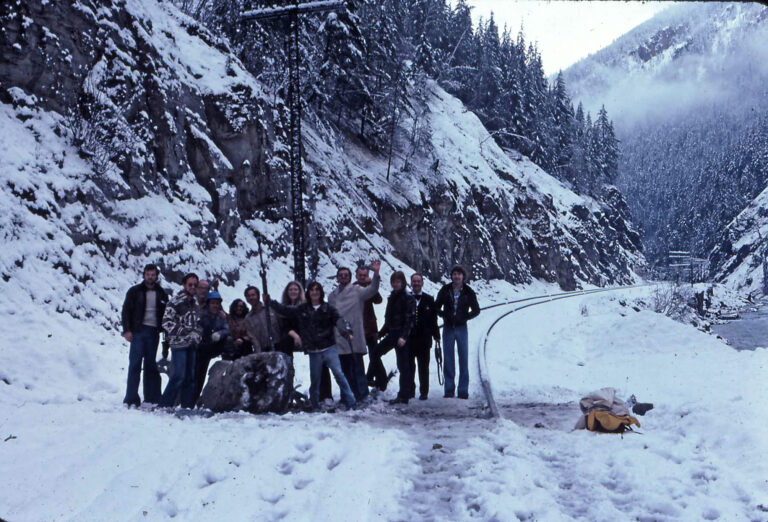
“I would say it was definitely in the top 10 of unusual things to happen,” John Cowan says over the phone from his home in Maple Ridge, B.C.
“So many things have happened, but I think probably the rock with the passengers is probably one of the most unique. It was so against the rules and nobody questioned it, but we probably save two hours by getting these passengers out to do it.”
It was Oct. 29, 1978, and Canadian Pacific’s world famous passenger train, The Canadian, was at a standstill. After leaving Vancouver the day before, Conductor Len Timpany and the train crew—including Cowan who was then a brakeman in his early 20s—made an emergency stop in the Kicking Horse Canyon just outside Golden, B.C. The reason? A patrolman checking for damage found a massive boulder sitting right on the track—one big enough to send them crashing off course and into the nearby river.
“I could see the big rock up on the track on the curve,” remembers Cowan, now 64. “I got off the train and I walked up by myself. One of the engineers was up there. The conductor came up and we had a look. We said, ‘this is huge.’ The conductor said to the engineer, ‘you’d better get ahold of the operator … and get some maintenance guys out there.’”
What followed is something Cowan says would never even be attempted nowadays. After 20 minutes of waiting for a maintenance truck that never arrived, Timpany took matters into his own hands and enlisted some passengers to help push the boulder off the track.
“I’m not so sure I would have even done it then, with the liability of course,” Cowan says with a chuckle. “It was definitely a simpler time.”
“I thought, to myself, geez, the conductor’s actually doing this? I hope this is a good idea,” he added. “You wouldn’t dare do it in today’s world. If any of those people had got injured, say a sprained an ankle or hurt their back doing anything, and there was any kind of an injury claim put in through the company, we would have been in so much trouble.”
Cowan says roughly eight or nine men and a heavyset Saskatchewan farm girl volunteered their services. It took the combined efforts of all passengers and crew to budge the boulder from its place. Even then, they needed a little extra to get it completely off the track.
Cowan photographed the event, made copies, and mailed pictures out to all the passengers who took part. Afterwards, he threw away their contact information, something he still regrets.
The event rarely came up afterwards, not even with their bosses at Canadian Pacific.
“It’s so different now with the way management are at a lot of corporations, but a lot of these managers were old time,” Cowan says. “They were war veterans. They were tough, and there was so much more common sense in those days, let’s put it that way.”
After a 35-year career in the railway business, there isn’t much Cowan hasn’t seen. Now that he’s retired, the long-time conductor hopes to get back in touch with the people who helped the train crew remove that boulder so many years ago.
He got the idea from a newspaper editor in Golden, B.C., the town the train passed through not long before stopping. He’s decided to start his search in Saskatchewan, since that’s the one place he knows a passenger definitely came from.
“I don’t recall where the guys lived,” he says. “I definitely know the girl lived in Saskatchewan. I never forgot that. She lived on a farm in Saskatchewan.”
Cowan has had some success so far. One old CP conductor recognized someone as a Golden, B.C. resident when the photos appeared in an Alberta newspaper. The rest have been more elusive, but Cowan maintains a positive attitude, especially since he’s only started his search.
The story of the CP boulder is just one of dozens that made its way into a book he wrote about his experiences conducting trains through British Columbia. Cowan hopes the passengers would be honoured to know their efforts have been documented for rail enthusiasts everywhere to read about, but first, he’s got to find them.
“I’m on a quest now and there’s no stopping me,” he says. “Once I decide I’m going to do something, there’s no stopping me. I only know how to do something one way when I decide to do it, and that’s big.”
Anyone who recognizes someone in Cowan’s photos can reach him on Facebook, or by emailing johnpcowan@shaw.ca.
‘Canadian Pacific Trackside 1977-2012’ by John Cowan will be available for sale by Morning Sun Books in April 2022.
